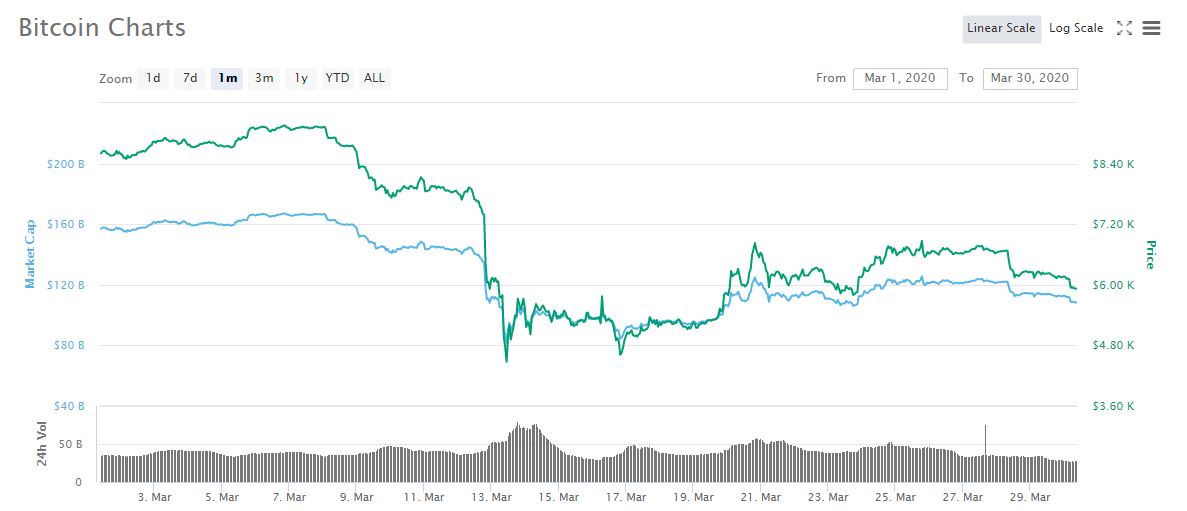Insights from Cryptocurrency Sentiment During Coronavirus Turmoil
Crypto sentiment swings echoed a tumultuous period for the market. Here are some insights to help you manage your portfolio during the next period of crisis.

Key Takeaways
- Crypto sentiment among Bitcoin and altoins ranged from lows in the teens to highs in the 90s in Q1.
- Crypto sentiment was sometimes event-driven, though not always. This offers traders in-the-know with profit-making opportunities.
- Only Bitcoin, Litecoin, and Ethereum saw sentiment dip to lowest Q1 levels on Mar. 12.
Share this article
The first quarter of 2020 was characterized by market turmoil caused by the coronavirus pandemic. How did cryptocurrency sentiment fare during those tumultuous months?
Crypto Sentiment
Crypto sentiment ratings have been recently released by trading platform eToro, using data from analytics firm TheTIE. Both short-term and long-term sentiment was measured in their report.
Short-term sentiment, or daily sentiment, measured 24-hour investor emotion against the previous 20 days. Long-term sentiment measured 50-day sentiment against 200-day sentiment. Both used the level of positivity or negativity in discussions on Twitter as a gauge. Sentiment below 50 was negative and sentiment above 50 was positive.
Bitcoin Proves Resilient During Market Turmoil
Despite a precipitous price drop on Mar. 13, 60% of the days in Q1 saw positive Bitcoin sentiment. Its highest sentiment score was 81, which occurred on Jan. 7. Its lowest sentiment level, not surprisingly on Mar. 12, saw sentiment plunge to 19.

As coronavirus concerns emerged, Bitcoin became less correlated with the S&P 500 and more correlated with gold. In March, Bitcoin and gold were more highly correlated than any other correlations between the three asset classes. That suggests the “Bitcoin as digital gold” narrative is far from dead. As the report indicated:
“Over Q1, nearly all cryptocurrencies experienced highly correlated daily price movement. With the exception of Dash, every coin hit its highest quarterly price between Feb. 3rd and Feb. 19th. Every asset dropped to its lowest point on Mar. 13th. However, over the first three months of 2020, digital asset returns varied drastically, from -22% to 58%.”
Altcoin Sentiment
The percentage of days during Q1 where altcoin sentiment was positive ranged from a peak of 67% for Stellar to lows of 45% for Ethereum Classic and Cardano.
Most altcoins spent about half to slightly under half the period with positive sentiment. The range was rather limited, from TRON with positive sentiment on 45% of all Q1 days, to Ether and IOTA in positive sentiment territory 57% of the time.
The highest altcoin sentiment level recorded during the quarter was 91 (out of 100), by EOS on Jan. 14 and IOTA on Feb. 11. IOTA sentiment was quick to fall, however, with the Feb. 12 Trinity wallet hack dragging sentiment firmly into the negative, at 17, on Feb. 14.
Altcoin sentiment levels during the period illustrate two things. First, notwithstanding testing market conditions, investors appear to tend toward bullishness. Second, when adverse events occur, such as the Trinity wallet hack, positive sentiment falls sharply. Markets seem to be positive, but fickle.
Monthly Variations
Zcash recorded the most negative sentiment level for the quarter of all coins, at 16 on Jan. 15. That came only ten days after it recorded sentiment highs of 82 on Jan. 15.
January was also a month of heightened sentiment volatility for NEO, Stellar, and EOS. All coins fell from their most positive to their most negative sentiment in January: EOS from 91 to 31 in 11 days, NEO from 85 to 29 from early to mid-January, and Stellar from 84 to 18 in a matter of four days. Coronavirus was largely confined to China, Korea, and Iran during the month, so would yet to have an impact on wider crypto market sentiment.
February proved more volatile for TRON and XRP. The former soared from 29 to 84 in only three days in early February. The TRON Foundation acquired Steemit mid-February. While the arrangement soured quickly, the partnership probably explains the dramatic rise in investor sentiment.
The Ripple-backed XRP fell from 83 to 27 in the middle of the month. Ripple failed to have the class action lawsuit against it dismissed at the end of February, potentially helping dampen enthusiasm for XRP.
Most Crypto Sentiment Closely Correlated
Most altcoin sentiment levels swung from lows in or just under the 20s to highs in the 70s or 80s throughout the period. Bitcoin Cash surged from 16 at the end of January to 78 by mid-February. Its halving event appeared to have little bearing on attitudes toward the coin. Cardano sentiment grew in January from a low of 25 at the beginning of the month to 83 at the end.
Interestingly, only two altcoins bottomed out in sentiment levels on the eventful Mar. 12. Ethereum sentiment hit 26 on that day and Litecoin sentiment, 22. That is in line with Bitcoin sentiment patterns. Despite a significant price surge at the end of March, Tezos sentiment peaked at 85 in early February.
Despite significant headwinds affecting all markets, crypto sentiment continued to hit peaks indicating bullish attitudes moving forward. Notably, the month of March—when the full impact of both the coronavirus pandemic and breakdown in oil talks between Saudi Arabia and Russia hit the news—saw less volatility in crypto sentiment levels.
Since TheTIE measured sentiment from Twitter analysis, it may be that COVID-19 dominated social media and as a result, the industry’s attention.
The economic threat the virus posed obviously hit crypto markets hard. With sentiment in all risk-on assets falling, there were lower volatility levels in March. Also, with traditional asset classes tumbling in value, perceptions of crypto rose toward the end of March as it significantly recovered from the Mar. 12 sell-off and began correlating strongly with gold.
Share this article
